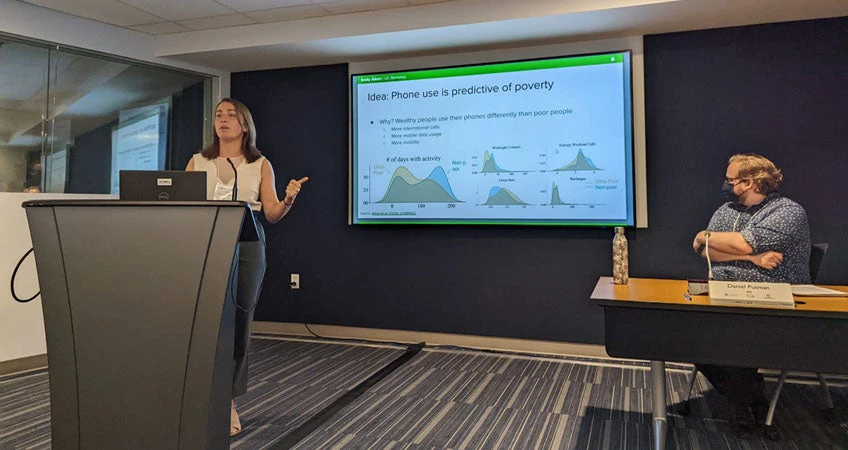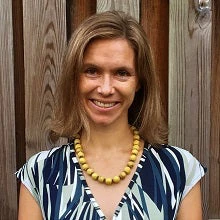Mobile phones generate a staggering amount of data, allowing researchers to address previously unanswerable questions, and answer existing questions with new depth and granularity. How are researchers making use of mobile data to address global development challenges? We discussed this question at Measuring Development 2022: The Role of Mobile Data in Global Development Research, the 8th edition of a conference co-organized by the Development Impact Evaluation (DIME) department, the Development Data Group’s Analytics and Tools (DECAT) unit, and the Center for Effective Global Action (CEGA) at the University of California, Berkeley. Below, we share a roundup with links to recordings.
Session 1: Mobile Data for Development (video)
Melis Guven, Global Lead for Social Protection Delivery Systems, highlighted the great promise mobile data holds for social protection, jobs, and resilience programs.
Emily Aiken (UC Berkeley) discussed using mobile phone data to target social assistance programs when recent data on socioeconomic status is not available. Working with the government in Togo, researchers used machine learning, combined with phone and survey data, to identify low-income individuals among all six million mobile subscribers.

Daniel Putman (UPenn) presented research in Haiti, showing how mobile phone data can be used to document activation of the social network in a time of crisis.
Xiao Hui Tai (UC Berkeley) showed how mobile phone data can be used to measure seasonal migration in Afghanistan. She uses location data from call detail records to estimate migration, combined with measures of poppy yield (derived from satellites), to remotely measure seasonal agricultural labor flows.
Mobile Data for Health (video)
Session 2A, chaired by Olusoji Adeyi, President of Resilient Health Systems, featured research on the use of mobile data to improve global public health.
Kibrom Tafere (World Bank) shared a paper suggesting that access to mobile technology correlates with substantial decreases in infant mortality, both directly (increasing access to health information and health services), and indirectly (improving welfare).
María Díaz de León Derby (UC Berkeley) discussed how her lab used machine learning to develop a unique mobile-based tool (LoaScope) to test for neglected tropical diseases. The LoaScope allows field staff with minimal training to identify diseases such as schistosomiasis without expensive equipment like microscopes.

Heather Amato (UC Berkeley) presented research on the prevalence of antibiotic resistant bacteria. Mobile data collection allowed the team to map bacterial loads in stool samples to risk factors from high livestock production areas.
Mobile data and COVID-19
Session 2B, chaired by Norbert Schady, Chief Economist for Human Development at the World Bank, focused on the uses of mobile data for research related to COVID-19. Watch the session here.
Victor Orozco (World Bank) demonstrated the value of educational technology apps and social media to amplify the effect of social behavioral change campaigns. He noted that the distribution stage is often the most important but neglected stage of public health interventions (as was the case with COVID-19 vaccination).
Arman Rezaee (UC Davis) discussed a social media platform experiment in Pakistan, testing how moderation impacts the spread of COVID-19 misinformation and subsequent engagement. Moderation reduced engagement, but aggressively disseminating accurate information counteracts this effect.
Lorenzo Lucchini (Bocconi) presented on the disparate impact of COVID-19 in developing countries, specifically on self-isolation, commuting patterns, and migration. Wealthier people reduce their mobility more than poorer people in response to COVID-19 restrictions.
State of Play: Mobile Data in Global Development Research (video)

Sveta Milusheva (World Bank) discussed the challenges of mainstreaming mobile data for global development research, including data access, privacy, data limitations, and interpretation. Access to mobile data is restricted due to the sensitivity of the raw data. Mobile data is not research-ready: limitations include incomplete data and anomalous data points. Interpretation of mobile data is not straightforward: the way people use phones changes over time. To truly mainstream mobile data, capacity must be improved at all levels of the ecosystem. Sveta proposed a call to action: open-source tools and trainings would allow mobile network operators to produce aggregate indicators themselves; sharing aggregated indicators facilitates access and addresses privacy concerns at the same time.
Mobile data for transport (video)
Session 3, chaired by Nicolas Peltier, Global Director for Transport at the World Bank, focused on the use of mobile data in transport.
Girija Borker (World Bank) presented on the use of mobile technology to report violence against women. Her research team created a smartphone app to encourage reporting of sexual harassment and violence in public transport. The pilot showed that incidence (measured by the app) was 59%, but only 1% was formally reported.
Robert Marty (World Bank) discussed how mobility restrictions from COVID-19 policies impacted road safety in Kenya. The team combines administrative police data with traffic reports and congestion data. They find that COVID-19 restrictions reduce mobility and congestion, but there is no proportional decrease in crashes, suggesting even greater incidence of crashes for the vehicles remaining on the road.
Alice Duhaut (World Bank) shared early-stage research on the impact of adding bus rapid transit in a highly congested city (Lagos). This collaboration with the Lagos transit agency, explores whether bus transit reduces congestion, and whether commuters value it or prefer cheaper informal options.
Florence Kondylis (World Bank) presented research using crowdsourced data from the Brazilian metro to measure women’s willingness to pay for the metro car reserved for women. They find that use of the gender-reserved car reduces incidence of harassment by half.
Methods for Mobile Data (video)
Session 4, chaired by Aart Kraay, Director of Development Policy and Deputy Chief Economist at the World Bank, covered the challenges and limitations of mobile data.
Vanessa Frías-Martinez (UMD) shared work using CDR-based measures of spatial dynamic and social ties to predict individual internal migration decisions. This can be used to create migration flow maps in contexts where primary data collection is not feasible.
Oscar Barriga Cabanillas (World Bank) spoke about testing use of CDR data for targeting or program evaluation for an emergency cash transfer program in Haiti. Only 34% of the target population had phones, and those that had phones rarely used them, which imposed strong data limitations.
Megan Lang (UC Santa Barbara) presented studies in Rwanda and Uganda on whether SMS surveys are sufficiently informative given low response rates, and showed that complimenting SMS with infrequent in-person surveys can reduce bias.
Dan Björkegren (Brown) discussed whether smartphones are informative about how people move. Smartphone penetration is still low, and smartphone owners are different from other phone owners, in terms of both who they are and how they use their phones. Smartphone owners use data, and make more transactions, so their location is observed more in CDR data; downsampling data users is important for comparability.
The conference ended with a round of short Lightning Talks by several researchers and industry experts, which you can watch here.



Join the Conversation